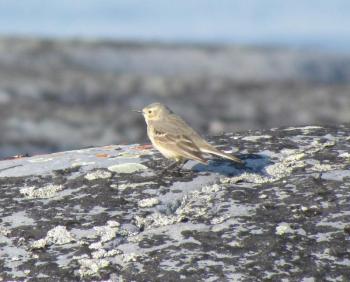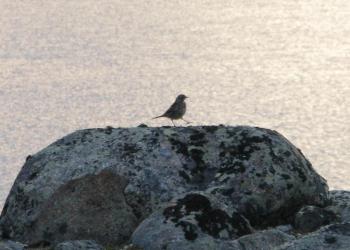They Don’t Get No Respect
It’s a bird that seems to pass through here in Maine quickly in spring. Though it is typically more widespread and abundant in fall migration, it prefers habitats that are often not heavily scanned by birders. During the migration seasons when most of us are likely to see it, the species is quiet and, by all accounts, rather drab in coloration.
It’s the American pipit (formerly known as the “water pipit,” for all you Old Timers), a species that don’t get no respect. But they deserve to.
Why?
Let’s start by noting that it’s on Maine’s Endangered Species List. Technically, it’s only the small breeding population on the tundra-like Tableland of Mt. Katahdin that is officially listed. Here and at the summit of New Hampshire’s Mt. Washington are the only two locations east of the Mississippi where American pipits breed in the U.S. The next closest breeding location is in Canada on some high elevation mountains in the Gaspé Peninsula of Quebec. Most American pipits, though, breed in open heathlands and tundra from Newfoundland across northern Canada to Alaska. In the western part of North America, they breed in high elevation open habitats south into California, Arizona, and New Mexico.
If you haven’t had the opportunity to peruse a pipit in detail, you might be forgiven at first glance for mistaking it for an odd sparrow. Most of the pipit species of the world (there are 35-50 species depending on the current state of taxonomic understanding, and they occur on every continent except Antarctica) are small, gray or brown birds with some streaking on the breast. They occur in open habitats where they walk around on the ground looking for insects (mostly) and seeds (occasionally). Most pipit species have a habit of wagging their tails, though some wag differently than others.
American pipits wag their tails up and down as they walk around on the ground. They’re typically found in open fields, along the edges of beaches, and open rocky coastline, saltmarshes, or even sometimes golf courses and large lawns. We saw a flock of about 15 this past week bopping around a flooded hayfield. Every now and then, something startled them, and they flew up, flashing another of their field marks: white edges to the tail.
Often the best way to detect a pipit is by listening for their distinctive high “pip-it” call, which they give when flying over. On the breeding grounds, they sing a repetitive song while in a flight display, like many other birds that breed in open habitats.
American pipits seem to be declining in numbers, by about 30% over the last decades, but are still estimated to number about 20 million in North America. They also appear to have been shifting their wintering range northward. Here in Maine, records of American pipits in December and January have increased over the last 20-30 years. Still, the greatest numbers spend most of the winter in the southern U.S. and northern Mexico, though occasional birds have been found as far south as Costa Rica.
All in all, the American pipit is a pretty cool bird, one deserving of our attention.
Jeffrey V. Wells, Ph.D., is a Fellow of the Cornell Lab of Ornithology and Vice President of Boreal Conservation for National Audubon. Dr. Wells is one of the nation's leading bird experts and conservation biologists. He is a coauthor of the seminal “Birds of Maine” book and author of the “Birder’s Conservation Handbook.” His grandfather, the late John Chase, was a columnist for the Boothbay Register for many years. Allison Childs Wells, formerly of the Cornell Lab of Ornithology, is a senior director at the Natural Resources Council of Maine, a nonprofit membership organization working statewide to protect the nature of Maine. Both are widely published natural history writers and are the authors of the popular books, “Maine’s Favorite Birds” (Tilbury House) and “Birds of Aruba, Bonaire, and Curaçao: A Site and Field Guide,” (Cornell University Press).


























